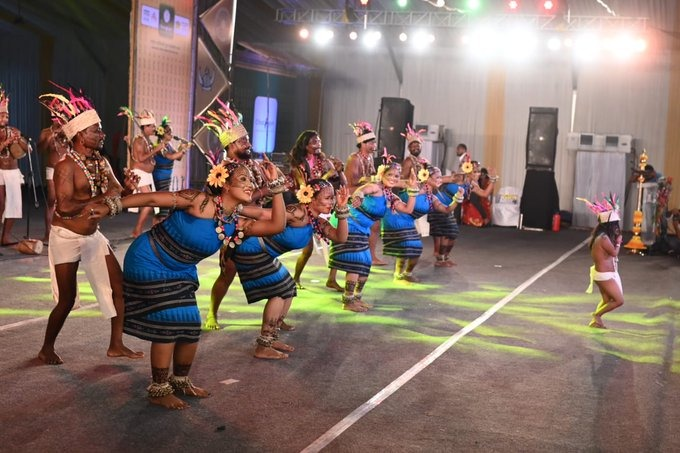Dhemsa on:
[Wikipedia]
[Google]
[Amazon]
Dhemsa is a traditional folk dance of

tribal people
The term tribe is used in many different contexts to refer to a category of human social group. The predominant worldwide usage of the term in English is in the discipline of anthropology. This definition is contested, in part due to conflic ...
of central India-Southern Odisha
Odisha (English: , ), formerly Orissa ( the official name until 2011), is an Indian state located in Eastern India. It is the 8th largest state by area, and the 11th largest by population. The state has the third largest population of ...
and adjacent areas of Chhattisgarh
Chhattisgarh (, ) is a landlocked state in Central India. It is the ninth largest state by area, and with a population of roughly 30 million, the seventeenth most populous. It borders seven states – Uttar Pradesh to the north, Madhya Prade ...
and Andhra Pradesh
Andhra Pradesh (, abbr. AP) is a state in the south-eastern coastal region of India. It is the seventh-largest state by area covering an area of and tenth-most populous state with 49,386,799 inhabitants. It is bordered by Telangana to the ...
. The dancers form a chain by holding each other by the shoulder and waist and dancing to the tune of traditional instruments. Dhemsa is a unique form of folk-dance which is performed in groups. Its uniqueness comes from its distinct style of composition, rhythm, body language, traditional costumes, hairstyles, and choreography.Description
Traditional folk instruments that are used in this dance are ''dhol
Dhol (IPA: ) can refer to any one of a number of similar types of double-headed drum widely used, with regional variations, throughout the Indian subcontinent. Its range of distribution in India, Bangladesh and Pakistan primarily includes nort ...
'', ''tamak'
The ''tamak' '' is a stick-struck double-headed drum of the Santal people of India
India, officially the Republic of India (Hindi: ), is a country in South Asia. It is the seventh-largest country by area, the second-most populous count ...
'', ''changu'' and ''mahuri''. Dhol is the bass drum
The bass drum is a large drum that produces a note of low definite or indefinite pitch. The instrument is typically cylindrical, with the drum's diameter much greater than the drum's depth, with a struck head at both ends of the cylinder. Th ...
, Tamak' is an instrument just like a bongo which maintains the tempo of the rhythm. Mohuri is a traditional musical instrument like Joruna. This dance is generally performed at late night by the tribes called "Desia" or "Adivasis" in all ceremonies including the annual ceremony "Chait Parab" and "Pus Puni" or "Pus Parab".
The person playing Mohuri is called "Mohuria" who plays the tune, and the drummers follow him.
Significance
This unique folk dance from Orissa is not just about the body movements but it combines multiple unique hairstyles, traditional costumes, group compositions, choreography styles, etc. It is played with a typical folk music in the background. It is a simple dance form which is a reflection of simplicity of the lives of the tribes of Odisha. Dhemsa is not just restricted to special occasions and festivals, but it is a part of the daily routine of tribal peoples. According to the local tribal people, it helps them to relax physically at the end of physically straining labor, and also serves as the main source of entertainment. Since it is a group dance, it also helps the people in the tribal community to come together and promote a feeling of brotherhood and harmony. Dhemsa is an integral part of their lives which is performed on the birth of a child to as part of the celebration. On the other hand, it is also used during the loss of a family member to help the family to cope up with the sorrow. It has a special significance during marriages as it is believed to bind the bride and groom together into a strong bond. It is a part of every tradition that is followed by the tribes of Orissa. The Dhemsa dance has rich artistry and a deep connection with the community. This dance form is the portrait of great philosopher “Gondi Punem Muthava Pahandi Pari Kupar Lingo”. The dancers form a chain by clutching hands with each other or embracing with other dancers at their shoulders and waists. It is performed bare foot on the soil, with the intention of making a connection with mother earth and paying obeisance to her. Dhemsa is every persons dance you don’t have to be expert to do a Rela the steps are simple but once you begin dancing you are mesmerized by it. It is performed during occasions like marriage ceremonies and is performed uninterruptedly over the entire night. This form of the dance is predominantly performed by the Gond & Pardhan tribe in various parts of eastern Vidarbha region of Maharashtra & Central parts of India.
Origin
There is no evidence available about the origin of this form of dance style. Instead, it has been carried from one generation to another by the tribes of Koraput district and has gradually spread to other districts like Bhotras, Bhumias, Kandhs, and Gadabas. This dance form is widely spread in Maharashtra state in Eastern part of Vidarbha region. Recently Kosodum Welfare Private Limited, has organized Dhemsa & Rela event in Mumbai region to promote the ancient dance form in the metro region. Tribal artists from Gadchiroli district will be performing this event.References
{{reflist Folk dances of Odisha